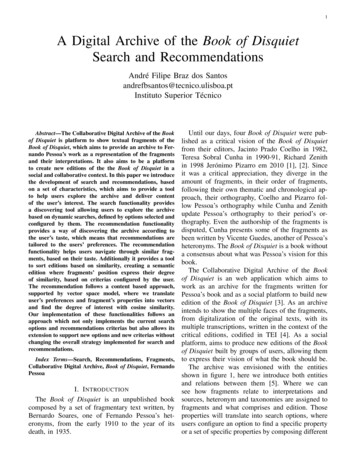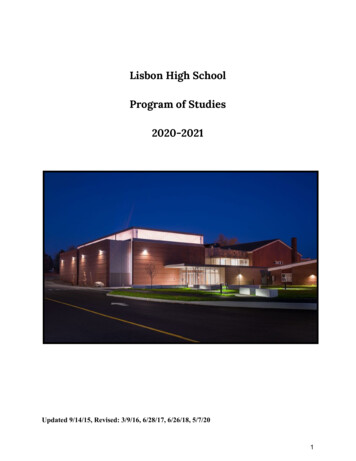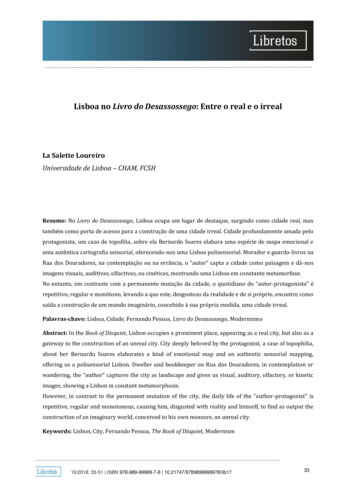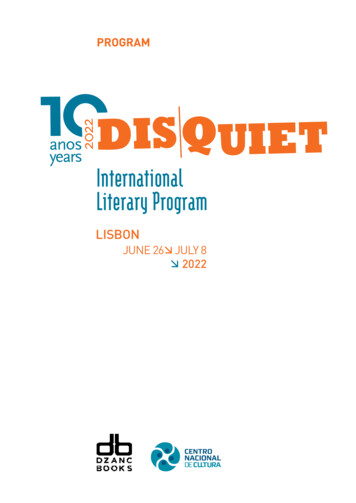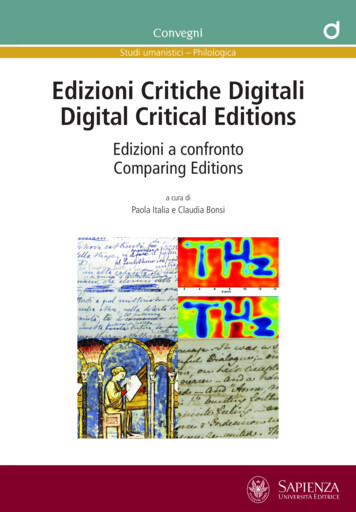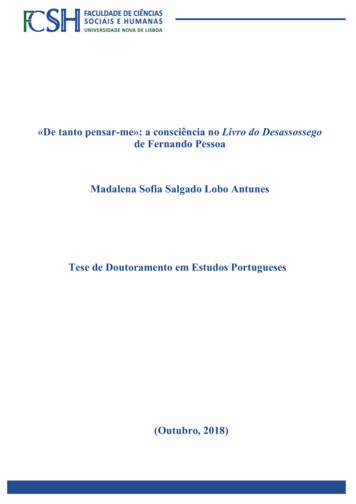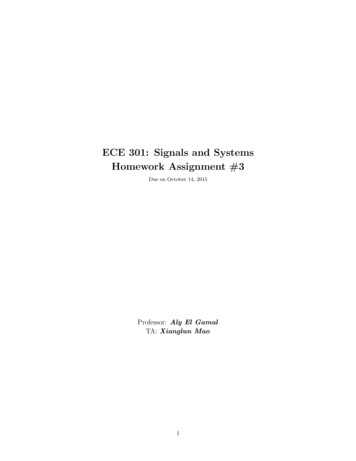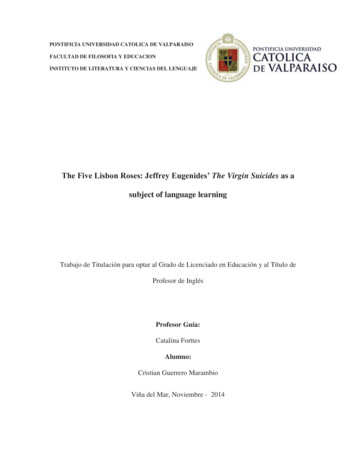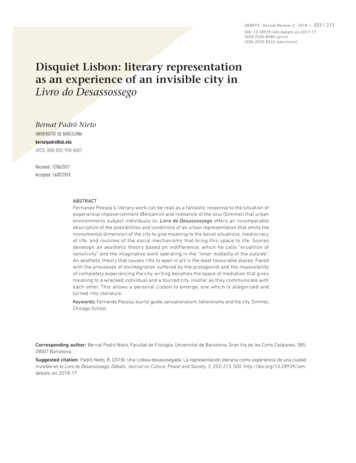
Transcription
DEBATS · Annual Review, 3 · 2018 —203 / 213DOI: 10.28939/iam.debats-en.2017-17ISSN 2530‑898X (print)ISSN 2530‑8262 (electronic)Disquiet Lisbon: literary representationas an experience of an invisible city inLivro do DesassossegoBernat Padró NietoUNIVERSITAT DE BARCELONAbernatpadro@ub.eduORCID: 0000-0002-9950-84827Received: 12/06/2017Accepted: 16/07/2018ABSTRACTFernando Pessoa’s literary work can be read as a fantastic response to the situation ofexperiential impoverishment (Benjamin) and indolence of the soul (Simmel) that urbanenvironments subject individuals to. Livro do Desassossego offers an incomparabledescription of the possibilities and conditions of an urban representation that omits themonumental dimension of the city to give meaning to the banal situations, mediocracyof life, and routines of the social mechanisms that bring this space to life. Soaresdevelops an aesthetic theory based on indifference, which he calls “erudition ofsensitivity” and the imaginative work operating in the “inner modality of the outside”.An aesthetic theory that causes rifts to open in art in the least favourable places. Facedwith the processes of disintegration suffered by the protagonist and the impossibilityof completely experiencing the city, writing becomes the space of mediation that givesmeaning to a wrecked individual and a blurred city, insofar as they communicate witheach other. This allows a personal Lisbon to emerge, one which is allegorised andturned into literature.Keywords: Fernando Pessoa, tourist guide, sensationalism, heteronomy and the city, Simmel,Chicago School.Corresponding author: Bernat Padró Nieto, Facultat de Filologia, Universitat de Barcelona. Gran Via de les Corts Catalanes, 585,08007 Barcelona.Suggested citation: Padró Nieto, B. (2018). Una Lisboa desasosegada. La representación literaria como experiencia de una ciudadinvisible en el Livro do Desassossego. Debats. Journal on Culture, Power and Society, 3, 203-213. DOI: http://doi.org/10.28939/iam.debats-en.2018-17
Bernat Padró Nieto204 — DEBATS · Annual Review, 3 · 2018Este livro é um só estado de alma, analisadode todos os lados, percorrido em todas as direcções.[This book is a single state of soul, analysedfrom all sides, investigated in all directions.]Exame de consciência, [Self-Examination]Bernardo SoaresThe city is, rather, a state of mind.Robert E. ParkIthe movement, / A fast colourful and human thingSofronia, one of the invisible cities imagined bythat passes and remains].1 This movement in theItalo Calvino, comprises two parts. One is madegreat European cities can also be exalted in the oneof stone and marble and of solemn monuments.situated furthest to the west:The other, of rope, fabric, and the machinery offairground attractions. One of them is provisionaland each year is dismantled so that it can go ontour through different cities. Contrary to commonsense, the fixed half of the city is not the one ofimposing buildings, but that of the fairgrounds.These are the palaces, ministries, and monumentsthat are taken down annually. Using this allegory ofthe city, Calvino led us to a key point: what definesurban life is not so much its cold urban design butrather, the pulse of life brought by the constantdynamism and ephemeral status of the interactions[The awakening of Lisbon city, later than theothers,The awakening of Rua do Ouro,The awakening of Rossio, at the café doors[ ].For me, nothing is as beautiful as the movementand the feelings.Life is a big fair and everything is tents andacrobats.I think of this, I am warmed, but I am notcalmed.]2that take place in it. We could add another volatileelement: the multiple melancholic memories thecity’s inhabitants have of the place they onceknew and which the very dynamics of changehave rendered unrecognisable. This provisionaldimension constituting ‘urban’ is recorded by Álvarode Campos, Fernando Pessoa’s heteronym, in apoem that celebrates the cosmopolitanism of themodern city and begins thus: [Ah, the first fewminutes in the cafes of new cities!], and whereafter mentioning the vehicles and the bustle of thecrowd he says: [And through all this, as somethingthat floods and never overflows, / The movement,1 “Ah, os primeiros minutos nos cafés de novas cidades! [ ]/ E através disto tudo, como uma coisa que inunda e nuncatransborda, / O movimento, o movimento / Rápida coisacolorida e humana que passa e fica ” (Campos, 2002, p.104). Translated into English by the article’s editorialtranslator.2 “Acordar da cidade de Lisboa, mais tarde do que asoutras, / Acordar da rua do Ouro, / Acordar do Rossio, àsportas dos cafés, [ ]. / Nada para mim é tão belo comoo movimento e as sensações. / A vida é uma grandefeira e tudo são barracas e saltimbancos. / Penso nisto,enterneço-me, mas não sossego nunca” (Campos, 2002,p. 97). Translated into English by the article’s editorialtranslator.
Disquiet Lisbon: literary representation as an experience of an invisible city in Livro do DesassossegoDEBATS · Annual Review, 3 · 2018 —There are many poems by Álvaro de Camposand he details the work found in several differentthat lyrically represent the city, whether it be themuseums and libraries, even including the entrancefuturistic celebration of technology as a new spacefees and opening hours of some of them. Everythingfor a modern epic as a ‘triumphant ode’; or be itpresented is accompanied by a historical accountthe elegiac recreation of a Lisbon linked to desireand these stories are as monumental as the Lisbonand lost forever amid the mists of the past, as inhe describes. It is a pragmatic book that uncriticallythe two ‘Lisbon revisited’ poems, one from 1923accepts the conjectures of modern life, such as,and the other from 1926. Between these two dates,for example, the virtue of technology or industrialFernando Pessoa wrote a text that was radicallytourism based on the identification and recognitiondifferent from those in his usual espólio [bodyof an imaginary already accepted before the visit—of work]. The book Lisboa: o que o turista deve verradically opposite postulates to those found in the(Lisbon: What the tourist should see, 1925) is a touristLivro do Desassossego (The book of disquiet), whereguide aimed at visitors–presumably British ones–we read: [If I were to travel, I’d find a poor copyarriving in the Portuguese capital by sea, whomof what I’ve already seen without taking one step]the narrator accompanies by car through the most(Pessoa 2001, p. 138)3. The assertion of modern life,aesthetically and historically representative placesthe references to British-inspired social clubs, andin the city. The 42-page long manuscript, typedthe use of the automobile as the preferred means ofout in English and complete and ready to publish,transportation has meant that some scholars see awas found by Teresa Rita Lopes’ team in 1988. Thissimilarity between the author of this tourist guidetext may have been part of a cultural policy projectand Álvaro de Campos’ early work, which celebrated,designed by Pessoa in scattered notes and motivatedwith exasperation, the triumph of cosmopolitanby what he called the ‘European decategorisation’technological progress. Yet, as we have already seen,of Portugal (Pessoa, 1993, p. 308). According toduring those years, Campos wrote melancholicPessoa, the systematic absence of Portugal inpoetry about a city revisited but not completelyforeign texts had to be combated. His programrediscovered. In any case, Lisboa: o que o turista deveproposed the creation of a general agency calledver is a book with an instrumental vocation and,Cosmópolis [Cosmopolis], a publishing companytherefore, is not poetic. If it had not been writtencalled Grémio Cultural Português [the Portugueseby this great Portuguese genius, we would not beCultural Guild], and even a Portuguese commercialdiscussing it here. However, it does give us theclub. The concerted action of these three institutionsopportunity to compare two possible representationswould aim to publish propaganda-like books andof Lisbon. The one of the official Lisbon, comprisingstudies about the country, as well as a book entitledmarble and statues, and the other Lisbon of LivroAll about Portugal, and would create a newspaper indo Desassossego, consisting of reflections andLondon called Portugal (Lopes, 1997, pp. 15–17).impressions captured by an individual trying toAmong the promotional material would be guidesmake himself, and his particular interactions withfor tourists, including the one he personally wrotethe urban environment, intelligible. As in the casewhich was eventually published posthumously.of Sofronia, the first Lisbon is incidental; the second,essential.The Lisbon offered in this guide is an objectifiedcity described with an institutional framing. Alongthe way, there are buildings, squares, monuments,panoramic views from urban viewpoints, andadministrative headquarters and other institutionsare pointed out. We are constantly given themeasurements of the buildings and monuments3 “Se viajasse, encontraria a cópia débil do que já vira semviajar”. We used the edition of Livro do Desassossegotranslated into English and edited by Richard Zenith(Penguin, 2001). Fragments (fr.) are cited by theirnumbering according to this edition and with thecorresponding title when dealing with the ‘largetexts’.205
Bernat Padró Nieto206 — DEBATS · Annual Review, 3 · 2018IIcomplicated4—lives on the fourth floor of one theThe now universal literary Lisbon is not a preciseregular buildings there and works in an office asparaphrase of its official self. It is the fantasticalan assistant accountant.Lisbon that some verses of the Pessoa ortónimo [hisorthonym, rather than a heteronym] and Álvaro deApart from these locations, which are barely mentioned,Campos ambiguously show, but, above all, it is thethe city is omnipresent but remains blurred: numerousone that emerges precisely and concisely in manystreets, squares, and gardens without names are referredof the fragments of Livro do Desassossego (Pessoa,to, as well as trams without numbers, which become2001). The objective correspondence between thejust as anonymous as the multitude of passers-by,city that undulates in dialectic of calmness and oneclerks and labourers who appear, protruding, in theof restlessness can be found in the Baixa Pombalinavarious fragments that make up the work. The Lisbonand its surroundings, a geometrically-designedrepresented in the Livro do Desassossego is not theneighbourhood with parallel and perpendicularpositive city described from a mental map like thestreets and architecture built with light-colouredone I provided above, but rather, is a city configuredstone. But he registers only meagre references toin the consciousness of one who lives in it yet has notit: the Rua dos Douradores; Praça do Comércio—fully experienced it. It is interesting that the Baixa—mentioned using its common name, Terreiro doaccording to Livro do Desassossego, a privileged urbanPaço—Rua d’Alfândega and Rua do Arsenal asspace—is almost completely ignored in Lisboa: o quemeridional coordinates, and on both sides, theo turista deve ver, where he limits himself to stating:hill of the São Jorge castle as a landscape that rises[From the Praça do Commercio we can go on to theto the east; the Santa Justa lift, which leads up tocentre of city by any of the three streets which go NorthBairro Alto and, further away, the São Pedro defrom there—Rua do Ouro on the left, Rua AugustaAlcântara viewpoint, as north-western references;and the estuary of the Tejo, with its mythicaldimension, as a surface upon which the sky isreflected. Occasionally he mentions the Benficaneighbourhood, as a distant, remote destinationwithin the capital; or the city of Cascais, which isperhaps less remote because, via the railway whichone can catch in Cais de Sodré in the southwestcorner of the Pombal neighbourhood, it is anextension of the Baixa. The centre of everythingis the Rua dos Douradores, a secondary street offthe Baixa that starts from the Praça da Figueiraand finishes in the Rua da Conceição, where tramnumber 28 passes by and then goes up to Graça. Butthe Praça da Figueira and the Graça neighbourhoodare mentioned only once, and the Rua da Conceiçãois never referred to. Only the metallic din of thetram or its bell sometimes appear. Therefore, theRua dos Douradores works as an indeterminateborder location where all literature and life areconcentrated, hence its augmented dimension:the poetic voice of the book—let us say, thatof Bernardo Soares so as not make matters too4 The Livro do Desassossego project was born at least a year beforethe creation of its heteronymic author, with the appearance ofthe text ‘Na Floresta do Alheamento’, the first creative prosepublished by Pessoa, in the magazine A Águia in August 1913.After the creation of [several] heteronyms in 1914, the projectwould go through several stages before being allocated thespecific name, Livro do Desassossego. Letters mentioning theproject from the years immediately following suggest that theauthor considered the work to be orthonymic. Between 1915and 1930, he doubted whether to attribute it to Vicente Guedesor Barão de Teive and, it seems, Pessoa worked on a firstcollection of fragments. Some of them even carry the followingannotation: “A. de C. ou L. do D.” which may mean “Álvaro deCampos ou Livro do Desassossego” [Álvaro de Campos or Livrodo Desassossego]; in 1930 he again attributed a fragment workto the name “ortónimo”, but from 1932, he decided that the workshould be signed by Bernardo Soares and even wrote the covertext “Do Livro do Desassossego, / composto por Bernardo / Soares,ajudante de guarda-livros na cidade de Lisboa / por / FernandoPessoa” [The Book of Disquiet, / written by Bernardo / Soares,assistant bookkeeper in the city of Lisbon / by Fernando Pessoa].Despite this, the cover text, as well as the letter to José GasparSimões from 28 June 1932, in which he says that “BernardoSoares no es un heterónimo, sino una personalidad literaria”[Bernardo Soares is not a heteronym, but a literary personality]shows that [Soares] is in fact a fictitious author. It would not beuntil 13 January 1935, in a letter to Adolfo Casais Monteiro, thathe would assign Soares the status of being ‘semi-heteronymous’(Crespo, 1984, pp. 187–193).
Disquiet Lisbon: literary representation as an experience of an invisible city in Livro do DesassossegoDEBATS · Annual Review, 3 · 2018 —(the one with the arch) in the middle, and Rua dasuggests sensuality only in the way the wind’sPrata on the right. Let us choose Rua do Ouro, which,whispering recalls voices, I meditate on theowing to its commercial importance is the main streeteternal insatiability of my vague desires, on theof the city] (Pessoa, 1993, p. 37). The constructivepermanent fickleness of my impossible yearnings.principle of the guide is orientation within the spatialI suffer mainly from the malady of being able toarrangement of the city. There is always a point ofsuffer. I’m missing something I don’t really want,reference that allows one to link each view of the cityand I suffer because this isn’t true suffering.75with the next. Regarding the description of Praça doComércio in the guide, he tells us:We now reach the largest of Lisbon (sic) squares,the Praça do Commercio, formerly Terreiro doThe size of the square, “uma das maiores do mundo”[one of the largest in the world] says the guide, thewidth of the Tejo estuary— “muito largo neste sítio”[very wide at this part], and the solemnity of the statuePaço, as it is still commonly known; this is theat its centre, are irrelevant in Livro do Desassossego.square which is known to Englishmen as BlackWhat Soares mostly records are moods:Horse Square and is one of the largest in theworld. It is a vast space, perfectly square, lined onthree sides by buildings of a uniform type, withhigh stone arches. All the chief public offices areinstalled here [.]. The fourth, or South, side ofthe square is formed by the Tagus itself, very widein this part and always full of shipping. In thecentre of the square stands the bronze equestrianstatue of King José I, a splendid sculpture byJoaquim Machado de Castro, cast in Portugal,in a single piece, in 1774. It is 14 metres high.The pedestal is adorned with magnificent figuresdepicting the rebuilding of Lisbon after the greatearthquake in 1755.6This is very dissimilar to the presence of this space inYes, it’s the sunset. Slowly and distractedly Ireach the end of the Rua da Alfândega and see,beyond the Terreiro do Paço, a clear view of thesunless western sky. It’s a blue sky tinged greenand tending towards light grey, and on the left,over the hills of the opposite bank, there’s acowering mass of brownish to lifeless pink fog.An immense peace that I don’t have is coldlypresent in the abstract fall air. Not having it,I experience the feeble pleasure of imaginingit exists.8It seems as if the Lisbon described were the onethat emerges from the street when the narratorlooks up over the houses and the hills; or over theroofs from the window of the fourth floor whereLivro do Desassossego, where it only becomes relevantinsofar as it affects the book’s subject, who writes:Sometimes I spend hours at the Terreiro doPaço, next to the river, meditating in vain. Myimpatience keeps trying to tear me away fromthat peace, and my inertia keeps holding methere. And in this state of bodily torpor that5 “Da Praça do Comércio podemos avançar para o centro dacidade por qualquer das três ruas que dali seguem paraNorte —Rua do Ouro à esquerda, Rua Augusta (a do arco) aomeio, e Rua da Prata à direita. Escolhamos a Rua do Ouro,que, devido à sua importância comercial, é a principal rua dacidade”.6 The translation English translation of Lisboa: o que o turistadeve ver was published by Shearsman Books (2008).7 “Passo horas, às vezes, no Terreiro do Paço, à beira do rio,meditando em vão. A minha impaciência constantemente mequer arrancar desse sossego, e a minha inércia constantementeme detém nele. Medito, então, num a modorra de físico, que separece com a volúpia apenas como o sussurro de vento lembravozes, na eterna insaciabilidade dos meus desejos vagos, naperene instabilidade das minhas ânsias impossíveis. Sofro,principalmente, do mal de poder sofrer. Falta-me qualquercoisa que não desejo e sofro por isso não ser propriamentesofrer” (Pessoa, 2012, fr. 107).8 “Sim, é o poente. Chego à foz da Rua da Alfândega, vagaroso edisperso, e, ao clarear-me o Terreiro do Paço, vejo, nítido, o semsol do céu ocidental. Esse céu é de um azul esverdeado paracinzento branco, onde, do lado esquerdo, sobre os montes daoutra margem, se agacha, amontoada, uma névoa acastanhadade cor-de-rosa morto. Há uma grande paz que não tenhodispersa fria-mente no ar outonal abstrato. Sofro de não tero prazer vago de supor que ela existe” (Pessoa, 2012, fr. 225).207
Bernat Padró Nieto208 — DEBATS · Annual Review, 3 · 2018he passes sleepless nights; or through the windowinto multiple personalities. The poem that beginsnext to his office desk. As if the urban complex[After all, the best way to travel is to feel] highlightsof the capital were the die from which the mosthis response:indescribable and intangible parts of Lisbon are cast:its atmospheric vicissitudes. In fact, more than a fifthof the 520 fragments comprising the first editionof the book—which is grouped thematically—aretotally or partially dedicated to these phenomena(Crespo, 1984, p. 213). These are moments—linked toreflection—which occur in writing when the authorbecomes self-aware and thematises the cognitiveThe more I feel, the more I feel like many people,The more personalities I have,The more intense, the shriller they are,The more simultaneously I feel them all,The more unitedly diverse, more diffusely attentive,Being, feeling, living, goingMore I will possess the total existence of the[universe.9processes that make the urban experience a relevantevent.At the same time, the depersonalisation caused byurban environments was also being theorised by thesociologists of the Chicago School. In 1938, LouisWirth affirmed: “Wherever large numbers of differentlyIIIconstituted individuals congregate, the process ofIn the same years Benjamin was working on hisdepersonalization also enters. This levelling tendencyreflections on the impoverishment of experience ininheres in part in the economic basis of the city”urban environments and [analysing] how this process(Wirth, 1938, p. 17). For his part, Robert E. Park hadwas artistically recorded in the literature of Baudelaire,stated in 1925 that:Proust, Kafka, and the Surrealists, Fernando Pessoa wasalso testing ways to open pathways for art amidst thebanality of his surroundings and of his life as a clerk.According to the German thinker, [Walter Benjamin],the urbanisation, demographic massification, andexpansion of technology in everyday life in big cities,permanently modified the conditions of perceptionand limits our ability to understand its citizens. Inturn, the mechanisation of [people’s] social lives androutine repetition deprives their activities of livingThe processes of segregation establish moraldistances which make the city a mosaic of littleworlds which touch but do not interpenetrate.This makes it possible for individuals to passquickly and easily from one moral milieu toanother, and encourages the fascinating butdangerous experiment of living at the same timein several different contiguous, but otherwisewidely separated, worlds (Park, 1925, pp. 40–41).of [true] content (Benjamin, 1972; 2012). Pessoa’sSo, it is not bold to say that the poetic project ofwork, like that of the authors Benjamin studied,the drama em gente [drama in people] was borneenigmatically encodes the complex tensions thatfrom the need to overcome the dead end in whichindividuals preserve—both between each other andmodern urban life situated individuals, isolatingwith their surroundings—when they are subject toand splintering their experiences into pieces thatthe impoverishment of experience. The sensationalistwere difficult to reconcile. Fernando Pessoa’s poeticprogram and the creation of heteronyms are artisticresponses to an existence subjected to the tyrannies ofthe protocols of urban life. ‘Feeling everything in everyway’ is a reiterative motto in the poetry of Álvaro deCampos. [He was] confronted with the homogenisationof experiences resulting from the unification of themodern world; diversification of modalities of feeling;with the process of urban depersonalisation; dispersion9 “Quanto mais eu sinta, quanto mais eu sinta como váriaspessoas, / Quanto mais personalidades eu tiver, / Quantomais intensamente, estridentemente as tiver, / Quanto maissimultaneamente sentir com todas elas, / Quanto maisunificadamente diverso, dispersadamente atento, / Estiver,sentir, viver, for, / Mais possuirei a existência total do universo”(Campos, 2002, p. 251). Translated into English by the article’seditorial translator.
Disquiet Lisbon: literary representation as an experience of an invisible city in Livro do DesassossegoDEBATS · Annual Review, 3 · 2018 —response arose from the artistic exacerbation ofthoughts].11 Furthermore, we find many variantsdepersonalisation and disintegration. What givesof this saying in Livro do Desassossego:such a fragmented work as Livro do Desassossego acertain unity is this same attitude towards urban life:what in 1903 the German sociologist Georg Simmelcalled Blasiertheit [a blasé attitude], indolence, or inthe terms Bernardo Soares preferred: indifference and,The cause of my profound sense of incompatibilitywith others is, I believe, that most people thinkwith their feelings, whereas I feel with mythoughts.above all, tedium. According to Simmel, individualsFor the ordinary man, to feel is to live, and towho inhabit large cities long to preserve theirthink is to know how to live. For me, to think isautonomy from the homogenising forces of society,to live, and to feel is merely food for thought. 12historical heritage, and the world of technology,and they resist being levelled and exploited byThe aesthetic elaboration of this indolence whensocial and technical mechanisms. In psychologicalopposed with the [aforementioned] external stimuliterms it is characterised as ‘the intensification of ais key to understanding the representation of Lisbon.nervous life’ (Simmel, 2001, p. 375) because of theThe street sounds, the noises of cars and trams,excess of impressions that [individuals] constantlysnatches of conversation, an image of a garden, orreceive and that their conscience is unable to fullyof a square or a street, reach the writer already dulledassume— [I’m an ultrasensitive photographicand exhausted, as if from a distance: [Through theplate] 10, affirms Bernardo Soares. According tofilter of my inattention, I hear fluid, scattered soundsSimmel, the individual in the big city reacts towhich rise like intermittently flowing waves fromthis accumulation of impressions not with feelingsoutside, as if they came from another world].13 Whatbut with logic and exaltation of the consciousness,is distant is, precisely, the city; a city in which oneand [in this way the reaction to new phenomena isis not really present because one lives within [thetransferred to the less sensitive psychic organ]. Thecontext of] an inflated and dramatic self-awarenessrational character of urbanites works in this way,caused by the intellectualisation of sensitivity. Theas [the shield of subjective life against the violencehabitat of the poetic voice of these fragments isof the big city] (Simmel, 2001, pp. 377–378). Yearsthe one of urban recreation, based on a process inlater, in 1920, in Beyond the Pleasure Principle (Freud,which this voice itself, in another fragment, is called2004) Sigmund Freud added that the methods of‘knowledge of sensibility’. It is, as we have alreadydefence that an individual develops against thesaid, an intellectualisation of sensibility: [There’s animpressions they receive from the outside, anderudition of acquired knowledge, which is eruditionwhich allow them to select, discard, or incorporatein the narrowest sense, and there’s an erudition ofthem, are precisely those which constitute thatunderstanding, which we call culture. But there’s alsoperson’s psyche. Consciousness, according to Freud,an erudition of the sensibility]. It is this mechanismappears as a defensive mechanism. Finding it isnear impossible to extract the urbanite from thissituation, Pessoa derived a whole aesthetic theory,11 “e eu sinto com o pensamento” (Pessoa, 2012, fr. 71).whose synthesis may be the famous verse in the12 “Aquilo que, creio, produz em mim o sentimento profundo,em que vivo, de incongruência com os outros, é que a maioriapensa com a sensibilidade, e eu sinto com o pensamento.Para o homem vulgar, sentir é viver e pensar é saber viver.Para mim, pensar é viver e sentir não é mais que o alimentode pensar” (Pessoa, 2012, fr. 71).poem ‘Ela canta, pobre ceifeira’. [She sings, poorreaper], which appeared in December 1924 in themagazine Athena, and which says: [I feel with my10 “Sou uma placa fotográfica prolixamente impressionável”,(Pessoa, 2012, ‘Milímetros’ [‘Millimetres’]).13 “Oiço, coados pela minha desatenção, os ruídos que sobem,fluidos e dispersos, como ondas interfluentes ao acaso ede fora como se viessem de outro mundo” (Pessoa, 2012,fr. 393).209
Bernat Padró Nieto210 — DEBATS · Annual Review, 3 · 2018that widens the poetic distance, allowing the fragmentsPessoa thus makes a virtue of necessity: the isolationof the city that reach the imagination to completeand anonymity which urban life brings him helpswith it:him to abolish every disturbing interaction, whileErudition of the sensibility has nothing to dowith the experience of life. The experience of lifeteaches nothing, just as history teaches nothing.True experience comes from restricting our contractwith reality while increasing our analysis of thatcontact. In this way our sensibility becomes broaderand deeper, because everything is in us – all weneed to do is look for it and know how to look.14indolence is used to favour a state of drowsiness,semi-consciousness, fatigue, or tedium, thus allowingimpressions to transcend this state, making themavailable for amplification by the imagination. Inthe fragment ‘O sensacionista’, Soares affirms that lifeis interesting insofar as it is convertible into dreams,and speaks of an exercise of “decorativismo interior”[interior decoration] as “o modo superior e esclarecidode dar um destino à nossa vida” [the superior andBut Pessoa–Soares not only focusses on theenlightened way of giving a destiny to our life].17development of these poetic processes, he alsoSoares even elaborates an [Aesthetics of indifference]:provokes them and generates their experimental[The ability to spontaneously abstract whatever isconditions; this requires a certain sophistication in‘dreamable’ from each object or event, leaving allthe mechanisms of sensitivity and consciousness.of its reality as dead matter in the Exterior WorldLivro do Desassossego is full of examples of and– that is what the wise man should strive for]18.reflections upon this process, such as the largeFollowing this method, the city often awakens asfragments entitled ‘Educação sentimental [Sentimentalan inner landscape.education], ‘Milímetros (sensaciones de cosas mínimas)’[Millimetres (the sensation of slight things)] or ‘Osensacionista’ [The sensationalist].15 In these heinsists that we must pay attention to minimal, trivialIVelements, because an insignificant life can only leaveThe landscape arises to the extent that a set of visualbehind a work if it is capable of giving meaning tophenomena are extracted from the continuum inwhat is mediocre. Or, as fragment 388 states: [Let’swhich it is presented; these are endowed with a unitymake the receptivity of our senses purely literary,of meaning tha
Disquiet Lisbon: literary representation as an experience of an invisible city in . bernatpadro@ub.edu ORCID: 0000-0002-9950-84827 Received: 12/06/2017 Accepted: 16/07/2018 ABSTRACT Fernando Pessoa's literary work can be read as a fantastic response to the situation of experiential impoverishment (Benjamin) and indolence of the soul (Simmel .
